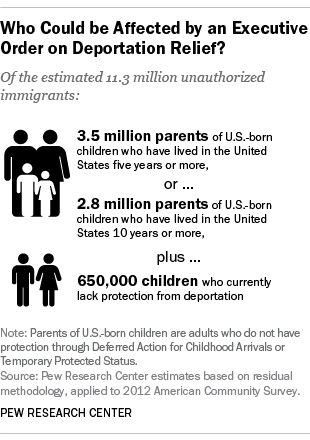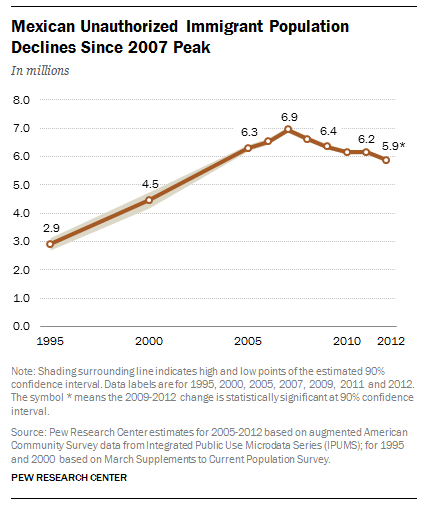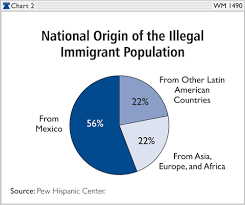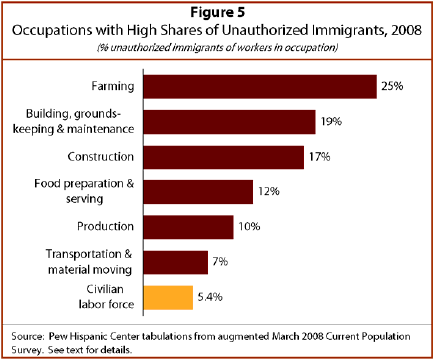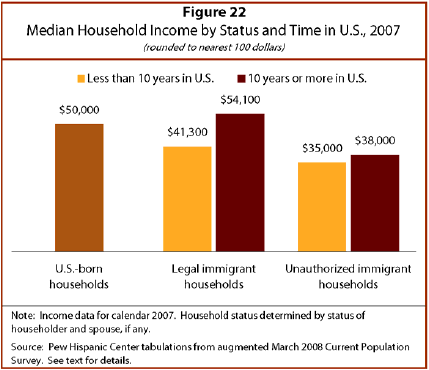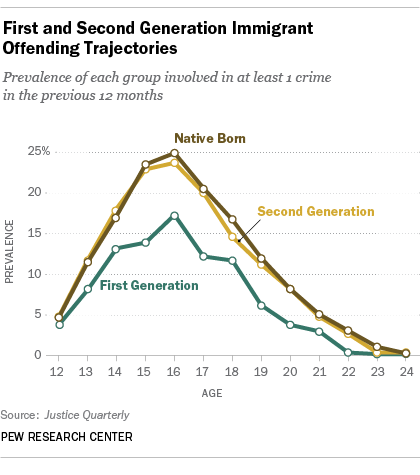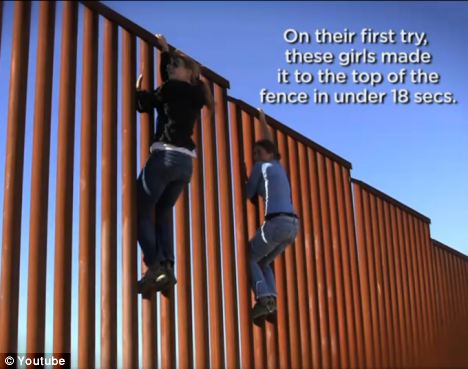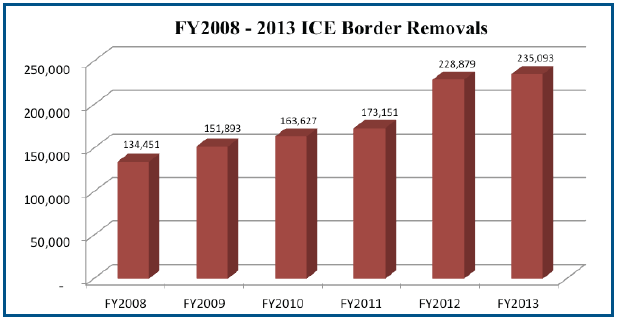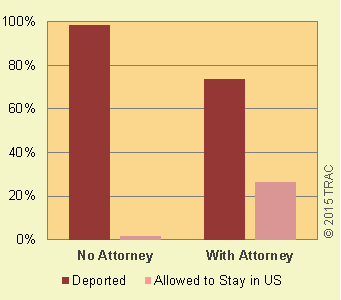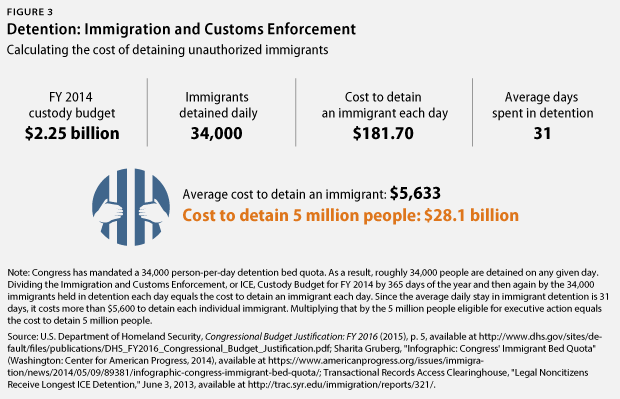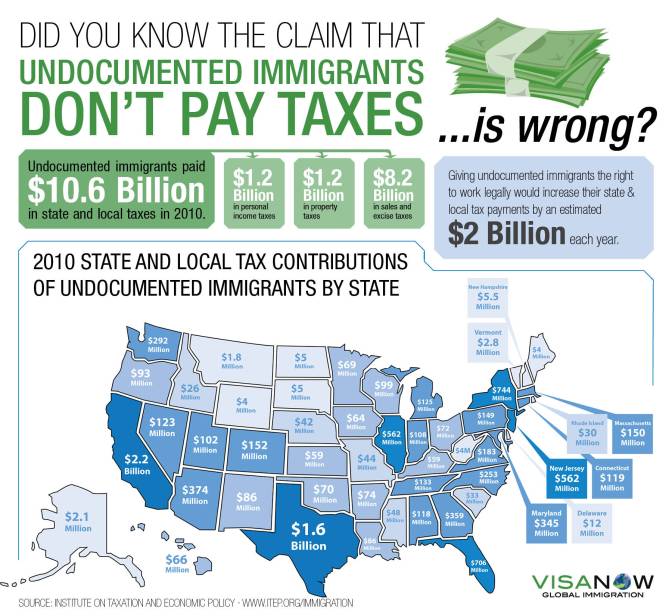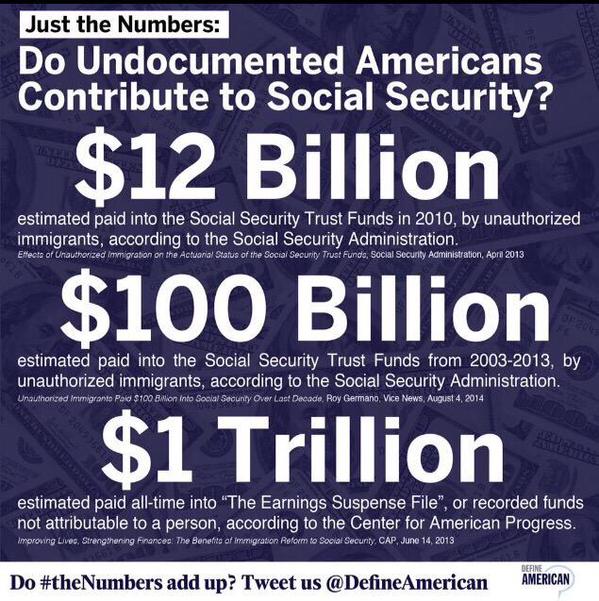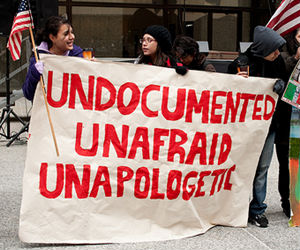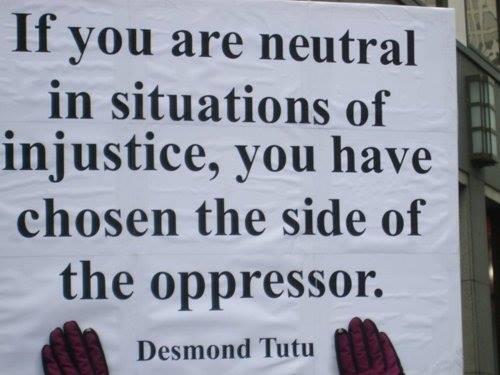Anchor Babies. Illegal Aliens. Illegals. The language and rhetoric used to describe the status of millions of people in the U.S. remains a shifting landscape, with a variety of terms tossed about to describe the current population of immigrants and undocumented workers.
The problem with these words remains that they foster a dehumanization of the people they describe, and also allow the user to avoid confronting the situations and motivations of millions of people who come to the U.S. seeking the privilege and opportunity this country symbolizes for many people.
Since that peak in 2012, the number of UD/UA workers has slowly declined, in part due to immigration efforts, and in part to the over 1 million immigrants deported by the Obama administration in the last seven years. Despite the criticisms of his opposition, Obama’s administration has continually made efforts to deport undocumented immigrants, with 438,421 unauthorized immigrants in 2013 alone, and an average of about 400,000 yearly since 2009.
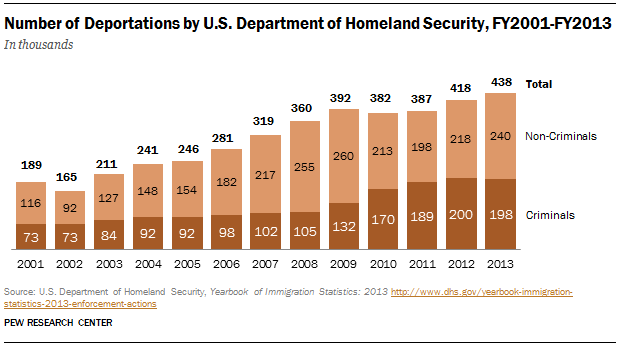 It is worth noting that the Obama Administration deported as many people in the first five years of his administration as Bush did in all eight. However, the Obama administration also facilitated the funding of two programs in the last few years to help some of the immigrants already in the U.S remain here and work towards citizenship.
It is worth noting that the Obama Administration deported as many people in the first five years of his administration as Bush did in all eight. However, the Obama administration also facilitated the funding of two programs in the last few years to help some of the immigrants already in the U.S remain here and work towards citizenship.
One is the Deferred Action for Childhood Arrivals (DACA) program, which states that certain people who came to the United States as children and meet several guidelines may request consideration of deferred action for a period of two years, subject to renewal and a wok permit for two years. They are also eligible for work authorization. Deferred action is a use of prosecutorial discretion to defer removal action against an individual for a certain period of time. Deferred action does not provide lawful status.
The other program is the Temporary Protected Status (TPS), may designate a foreign country for TPS due to conditions in the country that temporarily prevent the country’s nationals from returning safely, or in certain circumstances, where the country is unable to handle the return of its nationals adequately. This often occurs for one of three reasons, such as an ongoing-armed conflict, such as a civil war, an environmental disaster, such as earthquake or hurricane, or an epidemic.
The problem with these programs, beyond their administration falling under the purview of the Department of Homeland Security (DHS), is that only about 25-46 percent of all immigrants remain eligible for these programs, leaving a significant amount of people facing deportation from the U.S. Not to mention they function as temporary solutions that, when they end, leave people in similar circumstances prior to entry into the program.
Last November, after Congress failed to pass a sweeping immigration overhaul in 2014, President Obama issued executive orders allowing certain immigrants who are parents of U.S. citizens or legal resident children to apply for deportation reprieves and work permits.
The EO also expanded DACA and TPS, providing similar relief to immigrants brought to the U.S. as children. The orders, allowed into law, could affect as many as 5 million undocumented immigrants, creating a pathway to citizenship and alleviating an already overworked deportation system.
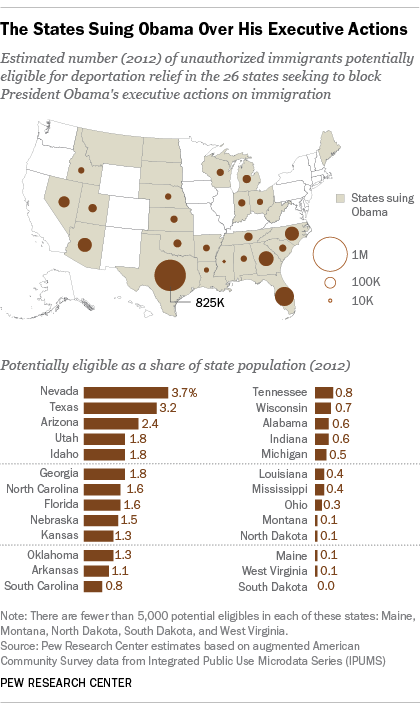 The 5th Circuit U.S. Court of Appeals is currently considering whether to uphold or lift the preliminary injunction imposed in that case, with a temporary injunction issued in February placing the actions of the Obama administration on hold until the court issues its ruling.
The 5th Circuit U.S. Court of Appeals is currently considering whether to uphold or lift the preliminary injunction imposed in that case, with a temporary injunction issued in February placing the actions of the Obama administration on hold until the court issues its ruling.
The EO marks the most significant protection from deportation offered to unauthorized immigrants since 1986, when Congress passed a law that allowed 2.7 million unauthorized immigrants to obtain a green card that then-President Ronald Reagan signed into law.
Making this issue omnipresent is the fact that much of the rhetoric coming from the Presidential campaign season focuses more on the perceived issues undocumented immigrants/workers represent in the minds of those who oppose their residency in the U.S. Discussions ranging from building a wall, to armed patrols, extending to nationwide deportations and denial of services, with some voices calling for the repeal of the Fourteenth Amendment, removing the right to citizenship extended to anyone born in the U.S.
However, while the rhetoric and couched language remain a constant, there is very little clarity in the presented arguments by candidates, and a plethora of misunderstandings that cloud the conversation and remove the chance to make forward progress on resolving this perpetual issue.
Below, this article will examine the collected information, statistics, and thoughts regarding the status and solution to the issue of UD/UA immigrants, and seek to offer correct information to foster greater understanding beyond buzzwords and couched phrasing.
Who are They and Why are They Here?
Out of the 11 million undocumented immigrants, about half, or 5.9 million, originate from Mexico. Another 2-3 million originate from Central and South America; with the five largest U.S. unauthorized immigrant populations include three in Central America, El Salvador, Guatemala and Honduras, with the fifth, India, accounting for less than 2 percent of all undocumented immigrants.
Additionally, unauthorized immigrants countries of origin include Asia (11%), Central America (11%), South America (7%), the Caribbean (4%) and the Middle East (less than 2%).
Six states alone account for 60% of unauthorized immigrants: California, Texas, Florida, New York, New Jersey and Illinois. Overall, there were seven states in which the unauthorized immigrant population increased: Florida, Idaho, Maryland, Nebraska, New Jersey, Pennsylvania and Virginia.
Meanwhile, there were 14 states in which the population decreased over the same time period: Alabama, Arizona, California, Colorado, Georgia, Illinois, Indiana, Kansas, Kentucky, Massachusetts, Nevada, New Mexico, New York and Oregon.
Despite the decline, Nevada has the nation’s largest share (10%) of unauthorized immigrants in its state population, with many finding work in Las Vegas and Reno in casinos and restaurants.
According to Pew research, in 2010 about two-thirds (62%) of all UD/UA lived in the U.S. for at least 10 years and almost half were parents of minor children. Only 15 percent had lived in the U.S. for less than five years. In other words, many of the UD/UA immigrants have already made a home here in the U.S.
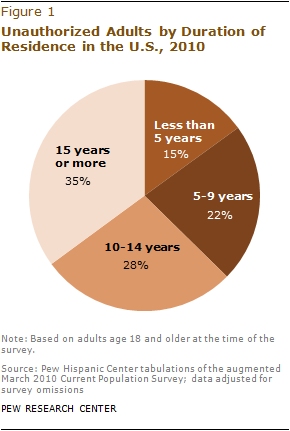 Overall, unauthorized immigrants make up 5.6 percent of the U.S. labor force. In the U.S. labor force, there were 8.1 million unauthorized immigrants either working or looking for work in 2014, with over 65 percent of all undocumented immigrants employed in varying fields. Among the states, Nevada (10%), California (9%), Texas (9%) and New Jersey (8%) had the highest shares of unauthorized immigrants in their labor forces.
Overall, unauthorized immigrants make up 5.6 percent of the U.S. labor force. In the U.S. labor force, there were 8.1 million unauthorized immigrants either working or looking for work in 2014, with over 65 percent of all undocumented immigrants employed in varying fields. Among the states, Nevada (10%), California (9%), Texas (9%) and New Jersey (8%) had the highest shares of unauthorized immigrants in their labor forces.
Additionally, the Department of Labor reports that of the 2.5 million farm workers in the U.S., over half (53 percent) are illegal immigrants. Many of these workers receive no job protections, health care, or equivalent pay with regards to documented workers.
Currently, there are about 2.8 million unauthorized adults with U.S.-born children currently living with them at home who have lived in the country 10 years or more but don’t have protection from deportation. Additionally, there are 650,000 unauthorized immigrant children who currently don’t have protection from deportation.
Out of the 43 million total immigrants, both legal and undocumented, 16.6 million people were in “mixed-status” families, those with at least one undocumented immigrant, in 2012. Nine million of these families had at least one U.S.-born child.
Nearly half of the undocumented population has minor children, many of them born in the United States. In 2012, 4.7 million undocumented adults were parents of minor children, including 3.8 million whose children were U.S. citizens.
Worth noting among some of the claims floated in the latest election cycle, is that the majority of unauthorized immigrants are struggling financially. According to recent research by Pew, the numbers are not positive, and do not support the immigrant on welfare narrative commonly portrayed in the current news cycle.
Adult unauthorized immigrants are disproportionately likely to be poorly educated. Out of the UA immigrants in the U.S., 47% have less than a high school education. By contrast, only 8% of U.S. born residents has not graduated from high school.
The 2012 median household income of unauthorized immigrants was $36,000, well below the $50,000 median household income for U.S.-born residents. In contrast to other immigrants, undocumented immigrants do not attain markedly higher incomes the longer they live in the United States.
A third of the children of unauthorized immigrants and a fifth of adult unauthorized immigrant’s lives in poverty. This is nearly double the poverty rate for children of U.S.-born parents (18%) or for U.S.-born adults (10%).
However, many of the UA/UD immigrants in the U.S. often work in limited industries, due to their lack of education or professional resources. In terms of overall numbers, The Department of Labor reports that of the 2.5 million farm workers in the U.S., over half (53 percent) are illegal immigrants
These figures offer insight into the lives and existence of U.S. UD/UA immigrants while also confronting many of the common narratives that have become pervasive and overshadow much of the conversation on immigration reform.
What about all the Crime and Lack of Contribution to the Economy?
According to Donald Trump, “”When Mexico sends its people, they’re not sending their best,” he said. “They’re sending people that have lots of problems, and they’re bringing those problems with us. They’re bringing drugs. They’re bringing crime. They’re rapists.”
Since his entry into the presidential race, Trump has made repeated comments about immigration, almost completely negative, with a furor only matched by his commitment to ignoring the facts and twisting stories to fit his narrative. Trump has called for a mass deportation, vowing to deport all 11 million UD/UA immigrants, while providing no real information as to how this would take place or how it would be accomplished, or by whom.
Let’s explore the claims he has made, while also confronting some of the dominant narratives used to support the policies and rhetoric that often treats UA/UD immigrants as less than human or as simply criminals without remorse, stealing from their benefactor, the U.S.A.
First, the claim that UD/UA immigrants cause crime and are generally, criminals exported by Mexico to create problems here, instead of across the border in Mexico.
One problem with this claim, Is that a 2007 study by the Immigration Policy Center found that the incarceration rate for immigrant men ages 18 to 39 in 2000 was 0.7 percent, while the incarceration rate for native-born men of the same age group was 3.5 percent.
While the foreign-born share of the U.S. population grew from 8 percent to 13 percent between 1990 and 2010, FBI data indicate that violent crime rates across the country fell by about 45 percent, while property crime rates fell by 42 percent.
However, data cited by Trump’s supporters from the U.S. Sentencing Commission states that they found undocumented immigrants account for high levels of violent crime. While they represent just 3.5% of the U.S. population, undocumented immigrants represented 7% of federal prison sentences following convictions on charges of sexual abuse, 9% of murders, 12% of assaults and 30% of kidnappings in 2013.
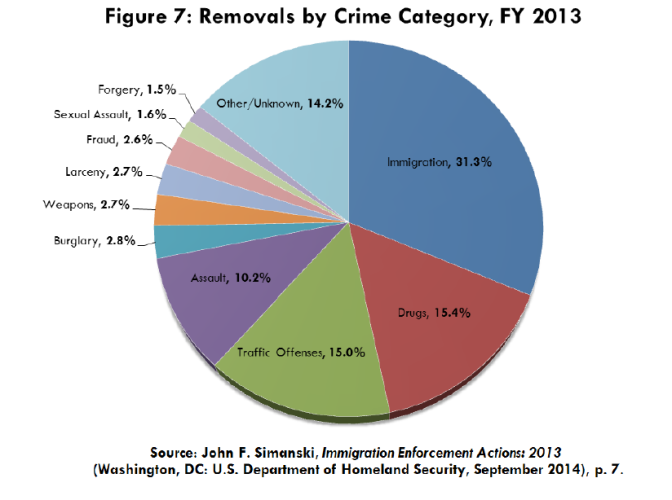 However, one must keep this in perspective. The Federal system handles a small amount of violent cases, and that 9% of murders cited above? It adds up to 8 total murders, 35 total assaults, and 12 kidnappings. Not exactly a crime wave.
However, one must keep this in perspective. The Federal system handles a small amount of violent cases, and that 9% of murders cited above? It adds up to 8 total murders, 35 total assaults, and 12 kidnappings. Not exactly a crime wave.
Also cited by Trump’s supporters is the fact that UD/UA immigrants make up 14 percent of federal inmates are illegal immigrants, the vast majority are incarcerated for immigration offenses, not violent crime. On the state level, less than 5 percent of inmates are UD/UA.
Also, most importantly, research shows that the crime rate among first-generation immigrants, those who came to this country from somewhere else, is significantly lower than the overall crime rate in the U.S. and that of the second generation of UD/UA children who are naturalized citizens.
In essence the claims of a Mexican crime wave created by scores of criminals sent to the U.S. from Mexico are false narratives designed to denigrate and falsely portray the vast majority of UD/UA immigrants for political gain and media showmanship.
We Should Build a Wall
Next for Trump and many others, is the stated desire to build a wall and increase border patrols to prevent UD/UA from entering the U.S. However, despite the attitude of many that a wall and firepower are the solution, the figures do not support this narrative.
While the prospect of building a wall from Baja to Texas broadly appeals to many, the reality is that it would be entirely untenable, in regards to both enforcement and the gargantuan price tag it represents.
While proponents of the wall, Trump included, remain happy to offer such a plan consideration of the economic black hole it represents is in short supply.
Currently, there is 670 miles of fencing along the border, with 700 miles still under consideration. Customs and Border Protection spent $2.4 billion between 2006 and 2009 to complete 670 miles of border fence, with the vast majority of the fence qualifying as was single-layer, essentially, one line of fencing designed to keep either pedestrians or vehicles from crossing into the United States, according to a Government Accountability Office (GAO) report from 2011.
The new plan, one mentioned by Trump, calls for a double-layer fence, with two parallel barriers on either side of a corridor manned by Border Patrol, that would require more land acquisition, more supplies and more labor to build, on top of the existing hundreds of millions spent on enforcement, construction and deportation services.
A 2009 analysis by the GAO found that the cost of pedestrian fencing ranged between $400,000 and $15 million per mile with an average of $3.9 million a mile. The price of less expensive vehicle fencing ran anywhere from $200,000 to $1.8 million a mile, for an average of $1 million a mile.
This is without factoring in the cost of buying private property for placing the fence along the border. Imagine how easy it will be to talk Texas landowners into selling their land or, if that fails, enforcing eminent domain to take control of the property.
In recent cases, it has shown that the cost of buying this land is astronomical, with many of the owners holding out for better offers. The Nature Conservancy, a well-known environmental group. Initially balked at an offer of $114,000 for a fence on its land in the Rio Grande Valley in south Texas, and ultimately settled for $1 million. A developer in Brownsville, Texas, was offered $233,000 but ended up with $4.7 million three years later.
The costs of a wall are unknown until they are finished, but the reality is that the perceived “savings” gained from building this wall are minimal, with the overall cost for the fence, not to mention continual, permanent maintenance once the wall is erected reaching well into the hundreds of billions of dollars.
The fiction offered by Trump and other politicians, that building the wall and maintaining it will “be easy” according to Trump, is not as simple as they present it, nor does it offer any real long-term solution to the problem of UD/UA immigrants. At best, it is a quick-fix designed to play to the anti-immigration rhetoric floating around for the last few decades, and at worst, it represents a fiscal hole that deepens the longer we ignore it or try and slap a band-aid over a gaping wound.
What About Mass Deportation and Enforcement of Existing Immigration Laws?
The reality is that the United States spends more on immigration and border enforcement annually than the annual gross domestic product of 80 countries. In fact, the United States now spends $3.5 billion more on immigration and border enforcement, a total of nearly $18 billion per year, than it does on all other federal law enforcement combined.
There were 662,483 apprehensions in 2013 by U.S. Customs and Border Protection (CBP) and U.S. Immigration and Customs Enforcement (ICE), the two agencies within DHS responsible for the identification and removal of inadmissible non-citizens.
Sixty-four percent of all apprehensions (420,789) were reported by the Border Patrol in 2013, up from 364,768 in 2012. About 98 percent of Border Patrol apprehensions (414,397) occurred along the Southwest border between the U.S. and Mexico.
Additionally, ICE Enforcement and Removal Operations made 229,698 administrative arrests (35 percent of total apprehensions in 2013) and ICE Homeland Security Investigations made 11,996 administrative arrests (2 percent).
Overall, the cost for apprehending, detaining, processing, and transporting in the deportation process is $23,482 per person.
363,000 (83%) of deportations were carried out without appearing before a judge – either through an order issued by an enforcement agent (called expedited removal) or by using a previous order of deportation (called reinstatement of final orders). Essentially, these immigrants receive no legal representation or a proper day in court to make their case; instead, they are simply arrested, detained, judged, and deported.
These numbers serve to highlight the scope of the perceived problem, with ICE, DHS, and CBP straining themselves to keep up, and failing as the consuming tide of UA/UD immigrants continues despite increasing efforts to crack down on immigration.
What about Mass Deportation? Well, based on a previous analysis from the Center for American Progress, a mass deportation strategy would cost an average of $10,070 per person (This is a low estimate), for a total of $114 billion to remove 11.3 million people.
This figure includes the high costs that would be required to find each and every unauthorized individual. Since two-thirds of the unauthorized population has been in the country for more than a decade, they are well settled into our families, communities and schools. Finding every single person without legal status would be a logistical nightmare that would cause significant social and emotional damage to entire communities and the economy.
CAP’s $114 billion estimate also includes the cost to detain these individuals while they wait for removal, to process them through the immigration courts and to transport them abroad.
While $114 billion represents a startling sum of money, it is only the direct cost of physically deporting unauthorized immigrants. The cost to the overall economy would likely be far more.
The conservative American Action Forum, or AAF, has argued that it would take 20 years to accomplish a mass deportation program, with a full cost between $420 billion and $620 billion.
This higher estimated cost includes both the direct costs of deportations and the hundreds of millions of dollars it would take for the U.S. Department of Homeland Security, or DHS, to remove 11.3 million people, on top of its responsibilities for border and interior security, over 20 years.
Beyond being prohibitively costly and morally unsustainable, removing so many individuals from the country, and from the labor force, would devastate the nation: The Bipartisan Policy Center calculates that deporting all unauthorized immigrants would shrink the labor force by 6.4 percent over a decade, which AAF estimates would decrease U.S. gross domestic product, or GDP, by a full $ 1.6 trillion.
Another analysis, by the Center for American Progress, says that if all undocumented immigrants in the country were deported, the United States’ cumulative GDP would suffer a hit of $1.6 trillion over 10 years.
Additionally, deporting the entire undocumented population would cost $285 billion over a five-year period, including continued border and interior enforcement efforts. To put that in perspective, the entire Department of Education budget totals a little under $72 million as of the 2014 fiscal year.
On the flip side, putting unauthorized immigrants on a pathway to citizenship—which two-thirds of Americans support—would add a cumulative $1.2 trillion to the GDP over a decade, increase the earnings of all Americans by $625 billion and create an average of 145,000 new jobs each year.
The most striking figure however, remains how long this mass deportation would take. Estimates by ICE, with current levels of deportation, claim it would take over 20 years to locate and deport the over 11 million UD/UA immigrants in the U.S.
Essentially, Trump’s idea of mass deportation is really a pipe dream; one that will cost trillions, create paranoia and confusion, and cause a massive financial hole that would take decades to repair. It looks to be long-term, difficult, and a losing fight.
It would appear that building a wall or mass deportation are costly ideas that sound compelling in stump speeches, that resound well with the majority voting base that often supports these measures, but in essence, they offer little hope for change, and do nothing to confront the idea that immigration is not a temporary issue, nor is it a simple issue a couple big policy ideas can properly fix.
However, the biggest illusion that remains regarding UD/UA immigrants is that they are a drain on the economy of federal, state, and local governments by using health care, schooling, public aid, and numerous other programs that allow them to benefit without contributing to the economy.
All They Do is Take Free Money and Contribute Nothing to the U.S. Economy
Like other Americans, UD/UA immigrants pay sales tax on their purchases and property tax on their homes. The majority of undocumented immigrants also pay income tax using Individual Taxpayer Identification Numbers (ITINs) or false Social Security numbers. These documents put workers “on the books,” which means their employers must make required deductions from their pay. An estimated three-quarters of undocumented immigrants pay payroll taxes and receive no access to the systems they pay into.
In 2010, UD/UA immigrants paid $8.4 billion in sales taxes, $1.6 billion in property taxes, and $1.2 billion in personal income taxes.
In 2012, out of the 11 million UD/UA immigrants currently living in the United States, they collectively paid $11.84 billion in state and local taxes.
For example, in Texas, UD/UA immigrants produce a net benefit at the state level.
Approximately 13.9% of the nation’s undocumented immigrants live in Texas, so it is safe to use them as a generalizable example given their almost 1/6th representation of UD/UA in the U.S.
In 2006, the Texas Comptroller reported that undocumented immigrants paid about $424.7 million more in state revenues including sales tax and school property tax, than they used in state services, including health care and education. In essence, UD/UA immigrants were essentially helping support a system they had little access to beyond sending their children to bi-lingual schools or enjoying the same public services everyone uses.
Here in Illinois, University of Illinois study found that undocumented immigrants in the Chicago metropolitan area alone spent $2.89 billion in 2001, stimulating an additional $5.45 billion in total local spending and sustaining 31,908 jobs in the local economy
In addition, undocumented immigrants are contributing to the Social Security system and they will never be able to receive any benefits unless they are allowed to become citizens and partake in the system they have given to without opportunity to access it.
One estimate showed that UD/UA immigrants contribute $9 billion a year to Social Security and that without their contributions, the potential shortfall in funding each year would cause significant funding and payout issues in the future.
Estimates from the Social Security Administration and the CBO suggest that at least 50 percent of undocumented immigrants pay federal taxes. Since the population does not frequently use social services, the loss in tax revenue associated with removing them from the country would cause the federal deficit to grow.
Each year, taxpayers who use incorrect or false Social Security numbers, the majority of whom are UD/UA immigrants contribute approximately $7 billion to Social Security and $1.5 billion to Medicare. Immigrants’ contributions to these programs are collected by the federal government to help meet its goals. Even though undocumented workers contribute to tax revenues on the local, state, and national levels, these individuals are ineligible for most government benefits.
Additionally, the money spent by UD/UA immigrants’ serves to increase the U.S. economy and contribute to long-term economic growth and job availability.
Dr. William F. Ford, a professor at Middle Tennessee State University and expert on taxes and immigration, calculates that undocumented immigrants contributed $428
billion dollars to the nation’s $13.6 trillion gross domestic product in 2006.
Undocumented immigrants utilize public and common resources but do not contribute to
the establishment and maintenance of those programs and infrastructures.
According to the National Research Council (NRC) of the National Academy of Sciences, the descendants of undocumented immigrants generate approximately $80,000 more each in taxes than they receive in state, federal and local benefits over their lifetimes.
Under Obama’s 2012 and 2014 executive actions, which would make temporary immigration reprieve available to up to 5.2 million undocumented immigrants, and as mentioned, remain on hold due to an injunction their state and local tax contributions would increase by an estimated $845 million a year once fully in place.
Essentially, the claim that UD/UA immigrants take more than their fair share and contribute nothing in return, is nothing more than a tired meme and a failed policy point made by politicians harnessing a wave of silent racism and xenophobia.
They Refuse to Learn English and Integrate into U.S. Culture
Finally, one of the final issues surrounding UD/UA immigrants is the empty claim that they will not learn English or integrate into our culture. While this claim has a grain of truth, it remains something many people refuse to understand or accept false narratives surrounding the how and why of the issue.
It is true that first-generation, non-English speaking immigrants predictably have lower rates of English proficiency than native speakers. However, 91% of second-generation immigrants are fluent or near-fluent English speakers. By the third generation, 97% speak English fluently or near fluently.
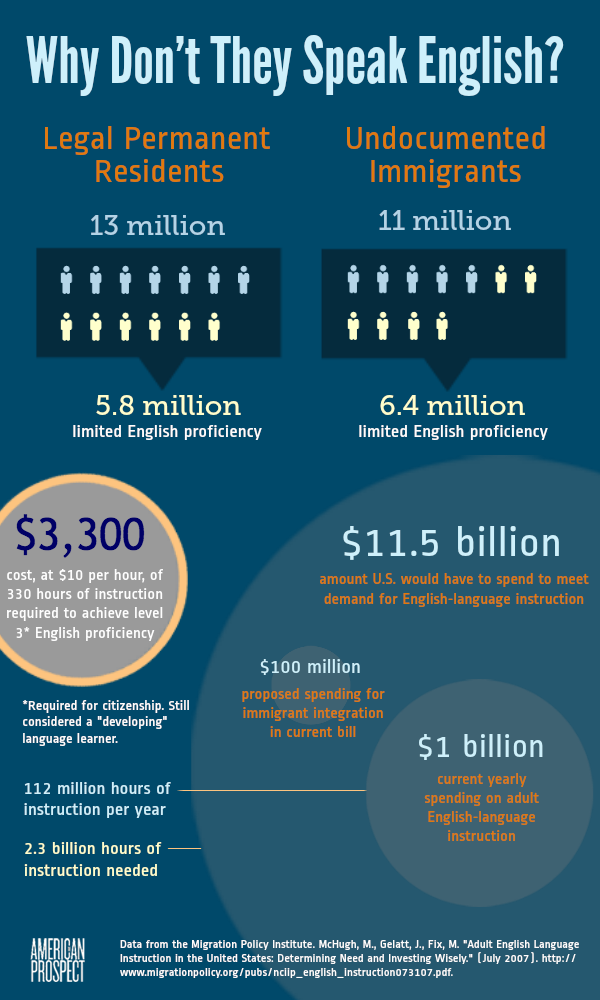 Additionally, some claim that UD/UA immigrants use college loans or grants to attend college on the taxpayer’s dime. However, this narrative is as the rest before it, false. As of July 2014, 16 states had active legislation granting illegal immigrant students in-state tuition benefits: California, Colorado, Connecticut, Illinois, Kansas, Maryland, Minnesota, Nebraska, New Mexico, New York, Oklahoma, Oregon, Rhode Island, Texas, Utah, and Washington.
Additionally, some claim that UD/UA immigrants use college loans or grants to attend college on the taxpayer’s dime. However, this narrative is as the rest before it, false. As of July 2014, 16 states had active legislation granting illegal immigrant students in-state tuition benefits: California, Colorado, Connecticut, Illinois, Kansas, Maryland, Minnesota, Nebraska, New Mexico, New York, Oklahoma, Oregon, Rhode Island, Texas, Utah, and Washington.
Additionally, it important to keep in mind that every single immigrant class that has come to America has had to learn the language, a process that takes a considerable amount of time, and dedication. The English language is considered one of the most difficult languages to learn in the world, and to act as though someone busy just trying to make ends meet also has time to partake in learning a language natural born citizens have trouble mastering is asking a lot.
While it is a lot to ask, many UD/UA immigrants are willing to do the work to become a natural citizen, and become fluent in learning how to communicate with English speaker. A recent survey of English training classes done in 56 major U.S. cities shows that any operated at full capacity for every single class offered. To claim they are not trying or that they HAVE to learn the language is similar to the racist rhetoric used against almost every single immigrant class that has come to the U.S. looking for work and opportunity to progress.
The biggest problem however, is that federal law provides only 5,000 permanent visas each year to “unskilled” workers, a category that covers most of today’s necessary workers. Temporary work visas and family-based avenues for entry are also extremely restrictive; it is not unusual for a Mexican resident to wait seven to nine years for a visa.
Hence, why many take the expedited route and come to this country as UD/UA immigrants, looking to avoid the gridlocked immigration system that issues visas and access to citizenship at a snail’s pace and at a cost outside of the reach of many immigrants.
What is the Solution for helping UD/UA Immigrants and Fixing the Problem?
The one solution that offers a long-term, comprehensive solution remains granting full amnesty to those already in the U.S., with conditions centered on making it easier to become citizens, pay taxes, and live in the organized society they have been long forced to navigate through while avoiding deportation.
The exploitation of UD/UA labor is a long-term and systemic issue, that forces immigrants to work for and pay into a system that offers them few permanent rights or access to programs they help support.
We need to work on fixing the broken visa program. Currently, there are over 4 million people waiting for visas, with certain classes of visas requiring wait times well over 5-10 years.
America proudly calls itself the home of immigrants, but the entry system of the country is so broken and problematic, it is the reason that many UD/UA immigrants make the choice to enter illegally. However, even for those who do get in, it is often easier to disappear into the U.S. than it is to obtain continuing documentation to stay in the country.
As many as half of immigrants arrive with legal documents, including passports and visas, that permit them to enter the U.S. territory. When their visa expires, they simply choose to not leave the country and in effect, become UD/UA immigrants.
However, the biggest issue is confronting the continual narrative of the other, the foreigner, the immigrant who doesn’t speak the language and has a different culture. Essentially, we’re afraid of bad things happening. The formation of chunks of the country where no English is spoken, higher unemployment, social services benefits we can’t afford to pay, more crime, new diseases.
Some of us are afraid, in whispered tones, of a country with a population that simply looks different from ours. Progressives are concerned that the Roman Catholic cultural influence from Latin America could contribute to more conservative social policy. Conservatives are afraid that an influx of Latino voters will give the Democratic Party an invincible majority in our elected government. But I think the greatest fear, the most pervasive fear, is a very different fear. It’s the fear of the unknown. It is the unarticulated fear that things will somehow change in ways that we can’t anticipate if so many people from a different culture, speaking a different language, praying different prayers and listening to different music and reading different books, come in and change what so many perceive as “America”
The reality is that America has and always will, change. Whether it was the influx of immigrant waves from Italy, Ireland, Eastern Europe, Japan, China, and now Central and South America bringing in new immigrants and increasing labor and economic output, or the same immigrants laying down track, piping, and now high speed internet, the face of what is “America” is ever-changing and malleable.
There is no bygone era where immigrants were not an integral piece of what has made this country a beacon. For many, to come to the U.S. and attempt to access the systems that built us into something worth doing and preserving is the American tradition.
A country that from its very inception was made by immigrants, shaped by immigrants, and furthered by the mass of cultures that has pushed this country forward through some of its most painful moments.
To deny the right to citizenship, to remove the Fourteenth Amendment, to deport people who live here and have built their lives, is a slap in the face to everything this country has accomplished. To deny the opportunity, the chance, to become a part of the diverse and unique cultural landscape of America is tantamount to rewriting the entire narrative of this country.
America was made by immigrants, belongs to immigrants, and survives because of immigrants. Do not allow fear and false narratives to mislead us into making a mistake we will regret for generations.
No one is illegal. No human is an alien.

